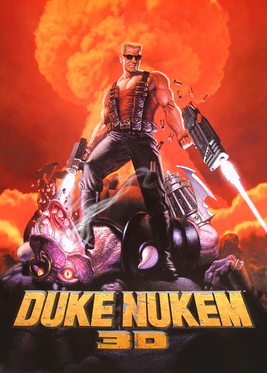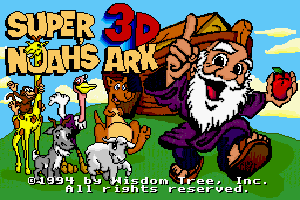This article relies largely or entirely on a single source .(December 2024) |
Duke Nukem Mobile is the name given to two different games in the Duke Nukem series developed by American studio MachineWorks Northwest and produced by 3D Realms.
This article relies largely or entirely on a single source .(December 2024) |
Duke Nukem Mobile is the name given to two different games in the Duke Nukem series developed by American studio MachineWorks Northwest and produced by 3D Realms.
This is a first-person shooter that was released in May 2004 for the Tapwave Zodiac, which re-uses many sprites (e.g. enemies and HUD weapons) that were already used in Duke Nukem 3D and consists of 21 short levels set in locations such as streets, strip clubs, cemeteries, mansions and a futuristic dirigible. In order to pass from a level to the next it is necessary to kill the enemies that are present in the current level, until one of them drops a key card that will enable the access to the next level.
In Summer of 2005, this game was ported to mobile phones as Duke Nukem Mobile 3D and enhanced to include a mode where the enemies are rendered as polygonal models.
In spring of 2007, the game was re-released for mobile phones again, under the title Duke Nukem Arena. It added a new survival mode and up to 4-player multiplayer Deathmatch.
In April 2020, a Nintendo DS development cartridge containing a port of Duke Nukem Mobile 3D called "Duke Nukem DS" was sold on eBay. A YouTube video containing in-game footage was uploaded by the user DScapades on May 3, 2020. [1]
This is a scrolling shooter that was released on January 15, 2004, to play on Motorola T720, LGE VX4400, LGE VX4500, LGE VX6000 and Samsung SCH-A530, with original graphics. The game features 15 levels and its gameplay consists in killing all of the enemies until the end-level boss is reached. When the boss dies, it will drop a key card that will enable the access to the next level. Also, when Duke Nukem dies in the game, he screams the roar of the aliens from Duke Nukem 3D.
In September 2005, a sequel called Duke Nukem Mobile II: Bikini Project was released for the same mobile phones. The game re-uses many sprites of its predecessor and takes place right after its end. The gameplay is the same, with new elements added such as the jetpack, the flamethrower, the pigcop jetcraft and multiple boss characters for some levels.

Duke Nukem 3D is a first-person shooter video game developed by 3D Realms. It is a sequel to the platform games Duke Nukem and Duke Nukem II, published by 3D Realms.

Hexen: Beyond Heretic is a fantasy first-person shooter video game developed by Raven Software and published by id Software distributed through GT Interactive on October 30, 1995. It is the sequel to 1994's Heretic, and the second game in Raven Software's "Serpent Riders" trilogy, which culminated with Hexen II. The title comes from the German noun Hexen, which means "witches", and/or the verb hexen, which means "to cast a spell". Game producer John Romero stated that a third, unreleased game in this series was to be called Hecatomb.

Quake is a first-person shooter game developed by id Software and published by GT Interactive. The first game in the Quake series, it was originally released for MS-DOS, Microsoft Windows, and Linux in 1996, followed by Mac OS and Sega Saturn in 1997 and Nintendo 64 in 1998.

Rise of the Triad: Dark War is a first-person shooter video game, developed and published by Apogee Software in 1995. The player can choose to play as one of five different characters, each bearing unique attributes such as speed and endurance. The game's story follows these five characters who have been sent to investigate a deadly cult, and soon become aware of a deadly plot to destroy a nearby city. A remake was designed by Interceptor Entertainment and released by Apogee Games in 2013. The shareware version of the game is titled Rise of the Triad: The HUNT Begins.

Duke Nukem Forever is a 2011 first-person shooter game developed by Gearbox Software and published by 2K for Windows, PlayStation 3, Xbox 360 and Mac OS X. It is the fourth main installment in the Duke Nukem series and the sequel to Duke Nukem 3D (1996). Players control Duke Nukem as he comes out of retirement to battle an alien invasion. Like its predecessor, Duke Nukem Forever features pop culture references, toilet humor, and adult content.

Super 3D Noah's Ark is a non-violent Christian first-person shooter developed and published by Wisdom Tree for the Super Nintendo Entertainment System (SNES) in 1994 and MS-DOS in 1995. Its gameplay is similar to that of Wolfenstein 3D, as Wisdom Tree had licensed that game's engine from id Software. Wisdom Tree opted not to secure a license from Nintendo for the game's SNES release. While not illegal, it prevented the game from being sold at most video game retailers, which were under a contractual agreement with Nintendo not to sell unlicensed games for the company's consoles. As a result, the SNES release of Super 3D Noah's Ark was sold primarily via Christian bookstores.

Blood is a 3D first-person shooter video game developed by Monolith Productions and published by GT Interactive and developed using Ken Silverman’s Build engine. The shareware version was released for MS-DOS on March 7, 1997, while the full version was later released on May 21 in North America, and June 20 in Europe.

The Build Engine is a first-person shooter engine created by Ken Silverman, author of Ken's Labyrinth, for 3D Realms. Like the Doom engine, the Build Engine represents its world on a two-dimensional grid using closed 2D shapes called sectors, and uses simple flat objects called sprites to populate the world geometry with objects.

Shadow Warrior is a first-person shooter video game developed by 3D Realms and published by GT Interactive. The shareware version was released for the PC on May 13, 1997, while the full version was completed on August 25, 1997 and released in stores on September 16, 1997. Shadow Warrior was developed using Ken Silverman's Build engine and improved on 3D Realms' previous Build engine game, Duke Nukem 3D. Mark Adams ported Shadow Warrior to Mac OS in August 1997.

Xevious is a vertically scrolling shooter arcade video game developed and published by Namco in 1982. It was released in Japan by Namco and in North America by Atari, Inc. Controlling the Solvalou starship, the player attacks Xevious forces before they destroy all of mankind. The Solvalou has two weapons at its disposal: a zapper to destroy flying craft, and a blaster to bomb ground installations and enemies. It runs on the Namco Galaga arcade system.

Ken's Labyrinth is a first-person shooter for MS-DOS published in 1993 by Epic MegaGames. It was programmed by Ken Silverman, who later designed the Build engine used for rendering in 3D Realms's Duke Nukem 3D (1996). Ken's Labyrinth consists of three episodes, the first of which was released as shareware. An earlier version was self-published by Silverman. In the game, the player assumes the role of a dog named Sparky trying to escape a labyrinth.
Fantasy Zone is a 1986 arcade video game by Sega, and the first game in the Fantasy Zone series. It was later ported to a wide variety of consoles, including the Master System. The player controls a sentient spaceship named Opa-Opa who fights an enemy invasion in the titular group of planets. The game contains a number of features atypical of the traditional scrolling shooter. The main character, Opa-Opa, is sometimes referred to as Sega's first mascot character.

PowerSlave, known as Exhumed in Europe and 1999 AD: Resurrection of the Pharaoh in Japan, is a first-person shooter video game developed by Lobotomy Software and published by Playmates Interactive Entertainment in North America, and BMG Interactive in Europe and Japan. It was released in North America, Europe and Japan, for the Sega Saturn, PlayStation, and MS-DOS over the course of a year from late 1996 to late 1997. On May 24, 2015, Powerslave EX, an unofficial remake of the PlayStation version appeared on GitHub. The MS-DOS version of PowerSlave was added to the GOG store on November 19, 2020.
Gradius is a series of shooter video games, introduced in 1985, developed and published by Konami for a variety of portable, console and arcade platforms. In many games in the series, the player controls a ship known as the Vic Viper.

Bionicle Heroes is a 2006 video game published by Eidos Interactive and TT Games Publishing and based on Lego's Bionicle line of constructible action figures. The game was released in November 2006 on PlayStation 2, Xbox 360, GameCube, Microsoft Windows, Game Boy Advance, and Nintendo DS; a Nintendo Wii version was later released in April 2007. The home console and PC versions were developed by Traveller's Tales, while Amaze Entertainment developed the handheld versions. A version of the game for mobile phones, developed by Universomo, was also released. The home console and PC versions of the game are third-person shooters, while the Game Boy Advance version is a run 'n' gun shoot 'em up and the Nintendo DS version is a first-person shooter. The story of Bionicle Heroes, where the player seeks to liberate the island of Voya Nui and its inhabitants from the villainous Piraka, is not canon to the official Bionicle story.
Duke Nukem is a media franchise named for its main character, Duke Nukem. Created by the company Apogee Software Ltd. as a series of video games for personal computers, the series expanded to games released for various consoles by third-party developers. The first two games in the main series were 2D platformers, while the later games have been a mix of first-person and third-person shooters.

A first-person shooter (FPS) is a video game centered on gun fighting and other weapon-based combat seen from a first-person perspective, with the player experiencing the action directly through the eyes of the main character. This genre shares multiple common traits with other shooter games, and in turn falls under the action games category. Since the genre's inception, advanced 3D and pseudo-3D graphics have proven fundamental to allow a reasonable level of immersion in the game world, and this type of game helped pushing technology progressively further, challenging hardware developers worldwide to introduce numerous innovations in the field of graphics processing units. Multiplayer gaming has been an integral part of the experience, and became even more prominent with the diffusion of internet connectivity in recent years.

Duke Nukem is a fictional character and protagonist of the Duke Nukem video game series. The character first appeared in the 1991 video game Duke Nukem, developed by Apogee Software. He has since appeared in multiple sequels and spin-offs, as well appearing in various games not in the series. Most recently, he starred in Duke Nukem Forever, released by Gearbox Software, which now owns the intellectual property rights to the series and the character.

Duke Nukem: Critical Mass is a shooter game developed by Frontline Studios and published by Deep Silver and Apogee Software, LLC for the Nintendo DS. A version for the PlayStation Portable began development, but it was never released.